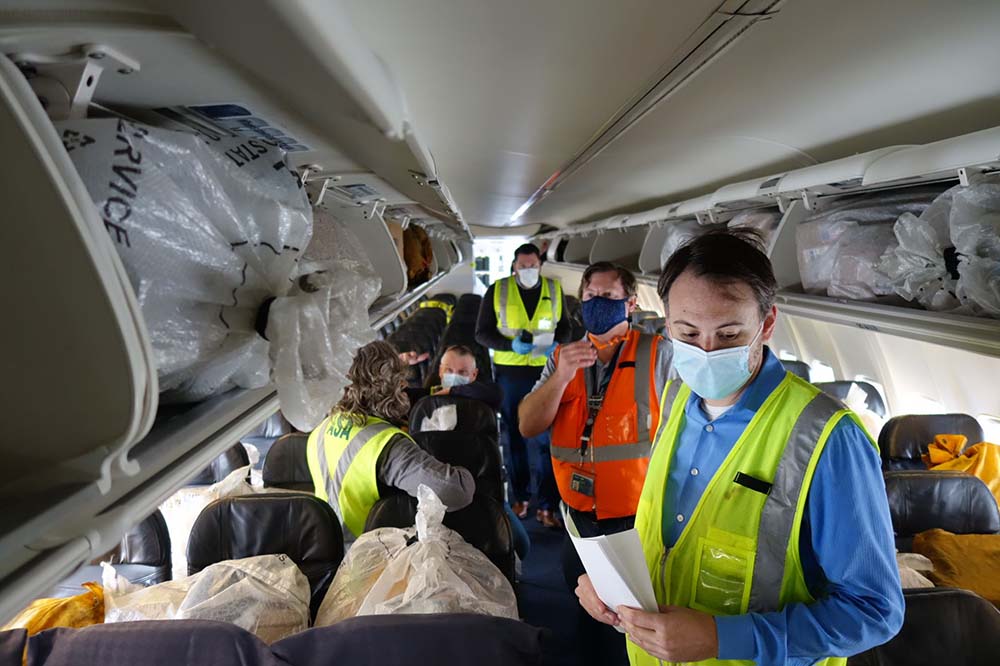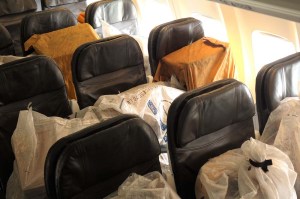Alaska Airlines begins testing passenger aircraft to fly critical cargo
Share

Alaska employees test loading cargo onto a passenger aircraft, securing the shipments and mapping a safe and viable process for leveraging passenger cabin space to ship critical cargo.
Since making the difficult decision to reduce our flying due to the coronavirus, we’ve been looking at other ways to utilize passenger aircraft to carry essential goods to people and businesses who need it most.
On any given day before the coronavirus dramatically changed travel, we carried about 400,000 pounds of cargo per day in the “bellies” of passenger aircraft – where luggage is stored. By utilizing passenger aircraft as freighters we’ll be able to backfill some of 45% loss in capacity across Lower 48 and Hawaii where passenger flights have been reduced by 80%.
“We’re determined to make sure our nation’s supply chain stays robust and resilient, connecting critical cargo quickly to the communities we serve,” said Torque Zubeck, managing director of Alaska Air Cargo. “Our teams have been working hard to identify the safest and most effective processes to increase our cargo capacity as quickly as possible.”
Trying to pull off a passenger-to-freighter operation is no easy task. A team of 40 people have been working on the effort since March. If approved by the FAA, we could begin flying passenger aircraft dedicated to cargo within the United States as early as May.
We aim to utilize the passenger cabin on five Boeing 737-900 aircraft – placing cargo boxes, mail and other items on and under seats, in overhead bins and in closets – creating room for an additional 13,500 pounds of cargo than a traditional passenger flight. In total, each flight will carry up to 30,000 pounds, including belly capacity.
The crew for these cargo flights will consist of two pilots and two flight attendants. The flight attendants will be seated in the main cabin to make sure the cabin is safe and secure and provide fire suppression if required, as passenger cabins do not have automated fire suppression systems like cargo compartments.
“Our cargo customers depend on us as much as we do them to fuel our supply chain with life-saving medical treatments, medical supplies and perishable foods that have a short shelf life,” said Rick Bendix, cargo marketing and business development program manager. “With the decrease in cargo capacity, this innovative approach allows to meet the demand of cargo customers whether “mom and pop” businesses or large freight forwarders who are working tirelessly to keep the critical goods moving.”

This week, a team of employees tested loading an aircraft, securing the shipments and mapping a safe and viable process for leveraging passenger cabin space to ship critical cargo. Protecting the areas of the passenger cabin where cargo will be stowed was incorporated in the test to ensure the passenger aircraft can easily return to carrying our guests when needed.

According to Anthony Johnson, Alaska Airlines senior engineer, the overhead bins are designed for stowage of carry-on luggage and are durable. However, we need to protect the seats by removing the life vests from under the seats and covering the leather with a protective fabric.
Our roots set us up for success
We’ve been delivering cargo to the state of Alaska for 88 years since our founding as McGee Airways. For some pilots, such as First Officer Bill Jacobson, flying the freighters is especially rewarding because he gets to see the impact cargo has on Alaska communities.

“Cargo is hugely important in the state of Alaska. We’re really the lifeline to many communities and bring things necessary to everyday life, like groceries, medicine and machine parts, just to name a few,” Jacobson said. “You usually meet the plane at one of our cargo buildings. When we’re walking through the cargo facilities, I’m often in awe of the variety of goods we’re hauling all over the state.”
These remote communities aren’t always connected by roads to the outside. When the grocery store is out of fresh produce or milk in remote communities in the state of Alaska, residents look to Alaska Airlines to deliver the supplies.
“Our cargo customers depend on us as much as we do them to fuel our supply chain with life-saving medical treatments, medical supplies and perishable foods that have a short shelf life,” said Rick Bendix, cargo marketing and business development program manager. “With the additional aircraft, we’ll be able to move these goods, as well as e-commerce orders, quickly and efficiently across the country keeping supply chains flowing and supporting our logistics and freight forwarding customers.”

Alaska Air Cargo Facts
By the numbers:
-
- Cargo planes (freighters): 3 Boeing 737-700s
- Cargo flown annually: 200 million+ pounds
- Seafood flown: 30 million+ pounds per year
- Destinations in Alaska we serve: 19 of 20 cities, only two connect by road
- Around 60% of our cargo business touches the state of Alaska in some way
- Total destinations served in 2019: 100+
- Freighter flights flown in 2019: 5,487
Typical cargo includes:
-
- E-commerce goods – such as books, clothing, electronics and more
Mail - Perishables – short shelf life/fragile items like herbs, lettuce and flowers
- Seafood and shellfish
- Medical – medicine, equipment and lab samples
- Equipment – such as critical parts to repair a fishing boat plane or logs to build bedroom furniture
- E-commerce goods – such as books, clothing, electronics and more
Key customers:
-
- Small businesses
- Seafood companies and distributors
- Medical labs and couriers
- Freight forwarders
- Logistics companies
